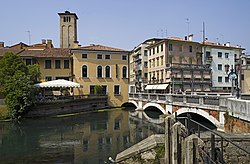Sile (river)
| Sile | |
|---|---|
 The Sile in Treviso | |
| Location | |
| Country | Italy |
| Physical characteristics | |
| Source | |
| • location | Vedelago in the Province of Treviso |
| Mouth | Adriatic Sea |
• coordinates | 45°28′44″N 12°35′03″E / 45.4790°N 12.5841°E |
The Sile (
Some of the rivers in the plain of the Veneto come from springs in the nearby Alps, while others have groundwater springs in the plain. The Sile originates in the plain and therefore it is a short river. Its springs are in the area of Albaredo, Casacorba and Cavasagra in the municipality of Vedelago. The fontanasso dea Coa Longa is considered to be the main spring. Two initial branches join at Morgano. The river has an initial west-east windy course which passes through or by Santa Cristina, Quinto di Treviso, Canizzano and Treviso. In Treviso it turns in a northwest-southeast direction towards the lagoon and passes by Silea, Casier, Cendon, Lughignano, Sant'Elena, Casale sul Sile, Quarto d'Altino, Trepalade and Portegrandi.
The Sile used to flow into the lagoon at Portegrandi in the municipality of Quarto d'Altino. However, in 1683 the
During Antiquity the Sile was connected to port town of Altinum through an eastern tract of the Siloncello canal which went close to its mouth at Portegrandi. At the time the River Piave must have flowed into the Sile. The Piave was a preferred route for the transport of wood from the forests of Cadore towards Altinum as attested by an inscription found in Feltre. Thus, this canal was of strategic importance for Altinum's supply of wood.[2]
The eastern tract of the Siloncello canal also turned south before reaching Portegrandi and reached the Palude di Cona in the Lagoon of Venice. Through this Altinum was connected with the lagunar channel of the Sile. This was a navigable route that gave Altinum's sea trade access to the Adriatic Sea. Altinum was eventually abandoned and its inhabitants moved to the islands of the northern part of the Lagoon of Venice. Torcello became the main administrative, religious and trading centre of these islands. It was the seat of the governor of the northern part of the lagoon. Its
In Dante’s “Third Sphere” of the Paradiso of his Divine Comedy, Cunizza da Romano predicts the fate of Riccardo da Camino, who was apparently murdered at a chess game. Dante located this event at the confluence of the Sile and the Cagnan, one of the branches the River Botteniga splits into when it reaches the gates of the town wall of Treviso:[5]
e dove Sile e Cagnan s'accompagna,
tal signoreggia e va con la testa alta,
che già per lui carpir si fa la ragna.
(And where the Cagnan and the Sile meet,
there’s one in power who goes with head held high:
the net to catch him is already made.)
Notes
- ISBN 978-8887505405
- ^ Tirelli M., Il Porto di Altino
- ^ Calaon D., Quando Torcello Era Abitata (When Torcello was Inhabited), Regione del Veneto, 2013. With English translation
- ^ Calaon D., Late Antiquity and Early Middle ages: warehouses, elites, and settlements, in Balliana E., Bernardi A., Biscontin G., Calaon D., Falchi L., Frigatti C., Izzo F. C., Longega G., Malaguti C., Marcanti A., Melotti E., Povolo C., Prezioso A., Savcic B., Scantamburlo C., Scatto D., Sgobbi M., Vidal D., Zendri E., Excavated Torcello, a shared heritage. With English translation
- ^ See Henry Francis Cary’s footnotes to his translation, 3rd edn. c.1844.
